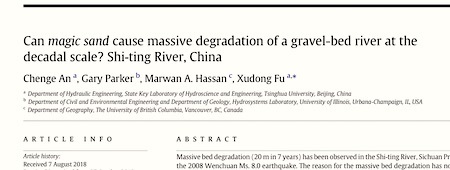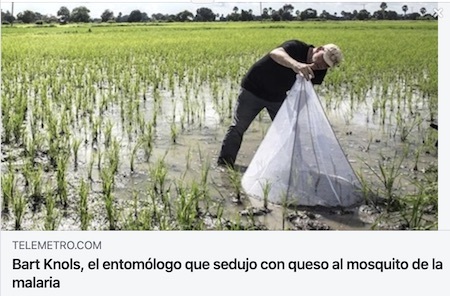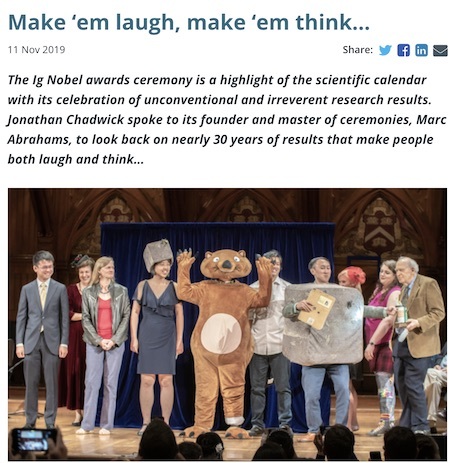Marc Abrahams's Blog, page 133
November 19, 2019
Nations use the Ig Nobel Prize as a propaganda cudgel
Every nation is keen to find new propaganda weapons to use against its rival nations. Some nations now gleefully use the Ig Nobel Prize.

Here’s a recent (September 18, 2019) example, in an editorial in the Japanese newspaper Yomiuri Shimbun:
Ig Nobel Prizes encourage people to enjoy science with a smile
Winners of the Ig Nobel Prize — an award that praises humorous achievements in scientific research — have been announced. Although the prize parodies the renowned Nobel Prize, there is much to be learned from it, such as a positive attitude toward enjoying science….
Japanese scientists have been awarded the Ig Nobel Prize for 13 consecutive years. Although the Japanese are occasionally said to lack originality, this may not be true regarding their capabilities in science. Their achievements seem to show the depth of generosity so firmly inherent in Japanese science that it accepts somewhat eccentric studies.
In contrast, China has received only a few Ig Nobel prizes, despite having produced a large number of theses in recent years. This seems to indicate that seemingly useless research cannot easily develop into anything good in an environment where practical studies are promoted as a state policy.
But in fact, many Chinese scientists have won Ig Nobel Prizes.
And China is home to a relatively new prize —the Pineapple Prize—that was created in homage to the Ig Nobel Prizes. Here’s a China.org news report about that, in 2012:
Pineapple Science Prize launched to promote science
A ceremony was held in Hangzhou Saturday evening to give away China’s first “Pineapple Science Prize”, which is designed to honor researches with great imagination and to arouse the public enthusiasm for science.
Jointly launched by China’s most popular science and technology social network Guokr.com and Zhejiang Provincial Science and Technology Museum, the first Pineapple Science Prize is expected to promote the country’s science popularization….
Pineapple Science Prize, with the slogan of “Laugh and Think,” was designed differently from ‘Ig Nobel Prize.’
“I was inspired by the ‘Ig Nobel Prize,’ but decided to make the prize more acclimatized to China. By launching the prize, we hope more people will get to know science and science will become more popular among the public,” Ji said.
“Some research topics seem to be weird but actually have deep meaning, which inspires us in a different way.”

November 18, 2019
The benefits of management short sightedness [new study]
 High-level decision-makers within a company often behave in a short-sighted way – with a pronounced lack of concern for what might happen in the future. In other words, they’re managerially myopic. You might think that such behaviour could damage a firm’s performance. And you’d be right. [See, for example, Blockholder Trading, Market Efficiency, and Managerial Myopia, a 2009 paper from Professor Alex Edmans of the London Business School.]
High-level decision-makers within a company often behave in a short-sighted way – with a pronounced lack of concern for what might happen in the future. In other words, they’re managerially myopic. You might think that such behaviour could damage a firm’s performance. And you’d be right. [See, for example, Blockholder Trading, Market Efficiency, and Managerial Myopia, a 2009 paper from Professor Alex Edmans of the London Business School.]
But maybe it’s not always detrimental? A new paper from Professor Cheng Li at Mississippi State University, draws attention to the (previously under-explored) benefits that short-sighted managers can bring to their firms.
“[…] a moderately myopic manager incentivizes the proponent of a risky long-term project to produce more information about the project, leading to more informed decision making and higher firm value.”
Raising the question – should myopic managers (who might inadvertently increase their firm’s value) be rewarded financially for their short-sightedness?
“Future work may examine the optimal compensation scheme for managers when the firm’s information environment is endogenously determined as in our paper.”
See: Informational benefits of managerial myopia in Economics Letters, Volume 185, December 2019. A full copy of which is currently available here via the professor’s website.
Research research by Martin Gardiner

November 15, 2019
Magic Sand and Degradation, at the Shi-Ting River
Degradation, over long periods of time, is a worry to some scientists, as is evident in this new study:
“Can magic sand cause massive degradation of a gravel-bed river at the decadal scale? Shi‑ting River, China,” Chenge An, Gary Parker, Marwan A. Hassan, and Xudong Fu, Geomorphology, vol. 327, February 15, 2019, pp. 147-158. (Thanks to Tom Gill for bringing this to our attention.) The authors, at Tsinghua University, Beijing, China; the University of Illinois, USA; and the University of British Columbia, Canada, report:

Massive bed degradation (20 m in 7 years) has been observed in the Shi‑ting River, Sichuan Province, China, since the 2008 Wenchuan Ms. 8.0 earthquake. The reason for the massive bed degradation has not been well understood. A hypothesis has been proposed that relates bed degradation to the augmentation of sand supply after the earthquake. The effect of sand on gravel mobility (magic sand effect) has long been observed in laboratory experiments. In this paper, we study whether the augmentation of sand supply and its magic sand effect can lead to the observed massive degradation at decadal scales….
Our simulation results also indicate that despite the fact that magic sand effects are not explicitly included in most sediment transport relations, they are at least partly built in via the hiding function that is contained in most sediment transport relations for gravel-sand mixtures.

November 13, 2019
The insect sex research adventures of Yoshitaka Kamimura
This insect-sex-reversal-centric profile of 2017 Ig Nobel Biology Prize co-winner Yoshitaka Kamimura appeared a year ago in the Keio Times:
Sex-Role Reversal Research in Insects Wins Ig Nobel Prize for Keio Professor Yoshitaka Kamimura
…In 2012, Prof. Kamimura was first invited to join a research team led by Kazunori Yoshizawa, an associate professor at Hokkaido University, whose award-winning research focuses on cave-dwelling species of insect from Brazil that belongs to the genus Neotrogla. In most insects, the male penetrates the female reproductive organ to transfer seminal fluid, but for Neotrogla, it is the female that has a penis, which it uses to penetrate the male in order to receive seminal fluid and nutritional substances.
“Neotrogla are small, 3mm-long insects that inhabit caves in Brazil. Our first face-to-face encounter with these fascinating creatures was in 2016, when we donned headlamps and explored the caves in search of them. The caves they inhabit are quite dry and food is scarce, which forces them to rely on bat guano and mouse droppings to survive….”

November 12, 2019
The entomologist who seduced malaria mosquitoes with cheese
“Bart Knols, the entomologist who seduced the mosquito mosquito with cheese” says the headline of this Telemetro [Panama] profile of Ig Nobel Prize winner Bart Knols and his innovations against malaria.
The 2006 Ig Nobel Prize for biology was awarded to Bart Knols (of Wageningen Agricultural University, in Wageningen, the Netherlands; and of the National Institute for Medical Research, in Ifakara Centre, Tanzania, and of the International Atomic Energy Agency, in Vienna Austria) and Ruurd de Jong (of Wageningen Agricultural University and of Santa Maria degli Angeli, Italy) for showing that the female malaria mosquito Anopheles gambiae is attracted equally to the smell of limburger cheese and to the smell of human feet.
Their Ig-winning research is documented in several publications:
REFERENCE: “On Human Odour, Malaria Mosquitoes, and Limburger Cheese,” Bart. G.J. Knols, The Lancet, vol. 348 , November 9, 1996, p. 1322.
REFERENCE: “Behavioural and electrophysiological responses of the female malaria mosquito Anopheles gambiae (Diptera: Culicidae) to Limburger cheese volatiles,” Bulletin of Entomological Research, B.G.J. Knols, J.J.A. van Loon, A. Cork, R.D. Robinson, et al., vol. 87, 1997, pp. 151-159.
REFERENCE: “Limburger Cheese as an Attractant for the Malaria Mosquito Anopheles gambiae s.s.,” B.G,J. Knols and R. De Jong, Parasitology Today, yd. 12, no. 4, 1996, pp. 159-61.
REFERENCE: “Selection of Biting Sites on Man by Two Malaria Mosquito Species,” R. De Jong and B.G.J. Knols, Experientia, vol. 51, 1995, pp. 80–84.

November 11, 2019
Laboratory News looks at almost 30 years of Ig Nobel stuff
There’s lots of quasi-juicy Ig Nobel history in this profile, in the British publication Laboratory News, by Jonathan Chadwick:

Umbilical cord storage doll and set thereof [new patent]
A newly issued US patent, awarded to inventor Hyunkap Park, of Siheung-si, South Korea, details an ‘umbilical cord storage doll and set thereof’.
“The umbilical cord naturally falls off a baby’s navel after a predetermine period has elapsed since the birth of the baby. Meanwhile, the umbilical cord has a special meaning in that it is a lifeline which has connected a mother and a baby for 10 months.
Furthermore, from the past, it has been said that the umbilical cord is a token of luck and fortune comes when the umbilical cord is possessed. In some homes, the umbilical cord was kept deep in a wardrobe. When a person experienced a difficult situation, he or she carried the umbilical cord as a charm.
As described above, as a conventional technology for the storage of the umbilical cord, patent document 1 discloses a seal capable of storing the umbilical cord, the seal including: a cylindrical seal body part configured such that a hole is formed through a side surface thereof and a longitudinal section surface is open; a transparent resin part configured to be inserted into the seal body part and to store the umbilical cord; and an engraving member configured such that a name is engraved on one longitudinal section surface thereof and another longitudinal section surface is inserted into the open longitudinal section surface of the seal body part; wherein the umbilical cord stored in the resin part can be viewed through the hole of the side surface of the seal body part.”
See: US patent 10,449,464 B2, October 22, 2019, Umbilical cord storage doll and set thereof
Research research by Martin Gardiner

November 9, 2019
Kwan-Liu Ma joins the Luxuriant Flowing Hair Club for Scientists (LFHCfS)
Kwan-Liu Ma has joined the Luxuriant Flowing Hair Club for Scientists (LFHCfS). He says:
(LFHCfS). He says:
I grew up in Taiwan, where—in the seventies—long hair was banned for students. Naturally, I started growing my hair once I moved to the US for graduate school. I have worn my hair long ever since, barring a brief short-haired period in my job hunting days in an attempt to look professional. I work on transforming data into visual representations for discovery and communication of insights. Though it lies in the field of computer science, my work involves a significant component of design and artistic expression. While I consider myself a designer by profession, people who meet me for the first time probably consider me a designer by hair. Over the years, I trust my visualizations (due to their aesthetics) have become as recognizable as my hair has at conferences. I am delighted to be a member of the LFHCfS—it is nice to be recognized for both my computer science work and my long flowing hair in the same membership.
Kwan-Liu Ma, PhD., LFHCfS
Distinguished Professor, Computer Science
University of California at Davis
Davis, California, USA


November 8, 2019
November 6, 2019
Hole Assessment by Finger and Tongue [research study]
A markedly penetrating report, involving fingers, tongues, and holes:
“Differences in the oral size illusions produced by cross-modality matching of peg and hole stimuli by the tongue and fingers in humans,” Bruce Melvin and Robin Orchardson, Archives of Oral Biology, vol. 46, no. 3, March 2001, pp. 209-13. The authors, at the University of Glasgow, Scotland, report:
“Individuals overestimate the diameter of 1-mm-deep stimulus holes presented to the tongue when they use their fingers to select a hole of matching diameter. The aim here was to determine whether the oral size illusion evident for 1-mm-deep holes would also occur with 1-mm-high pegs of similar diameters. The illusion was studied in 24 individuals who were blindfolded during the trials. The two sets of test stimuli were (a) 5 cylindrical pegs (1 mm high) and (b) five circular holes (1 mm deep), each of 2.5, 5.0, 7.5, 10.0, 12.5 mm dia. The stimuli were held to the mouth with one hand, while the fingers of the free hand were used to select a matching object from a comparator series of either 1-mm-deep holes or 1-mm-high pegs ranging from 2.0 to 18 mm dia…. Regardless of the nature of the stimulus (‘hole’ or ‘peg’), a mismatch between the stimulus and comparator was consistently seen only when the fingers probed comparator holes. The oral size illusion is not due to any intrinsic differences in the sensitivities of the tongue or fingers. Rather, the illusion is due to the inability of the fingertip to access small comparator holes.”

Marc Abrahams's Blog
- Marc Abrahams's profile
- 14 followers








